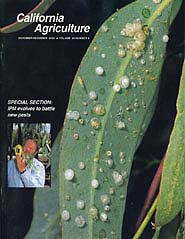All Issues

Special Section:
IPM evolves to battle new pests
Cover:
Several stages of red gum lerp psyllid, one of the newest eucalpytus pests. Inset, entomologist Don Dahlsten checks a trap to monitor the adult psyllid and its parasitoid. Photos by Jack Kelly Clark.
November-December 2000
Volume 54, Number 6
Volume 54, Number 6





